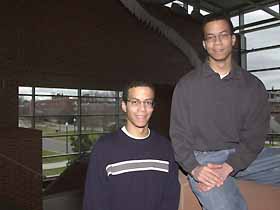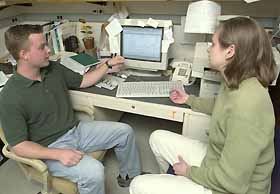|
April 10, 2000
Undergraduate Scholars Profiled
 University Scholar and
Presidential Scholar, Elizabeth Peterson
became interested in environmental science as a Girl Scout.
At UConn, she found that toxicology, which explores the effects
of toxins on living tissue, was not much of a leap from environmental
science. University Scholar and
Presidential Scholar, Elizabeth Peterson
became interested in environmental science as a Girl Scout.
At UConn, she found that toxicology, which explores the effects
of toxins on living tissue, was not much of a leap from environmental
science.
If she'd had any questions about the career direction she wanted
to pursue, they ended last summer, when she did research with
Professor Jose Manuatou, an expert on liver toxicity. The research
focused on colfibrate, a chemical that can reduce the toxicity
of acetaminophen.
The active ingredient in Tylenol and a component of some 200
other products, acetaminophen is an effective pain killer, but
can also damage the liver if it's taken for an extended period
in larger-than-recommended doses or if it's ingested in combination with alcohol.
Peterson's research specifically looked at acetaminophen's impact
on liver proteins and colfibrate's potential to mitigate damage.
Peterson, who is now completing her honors thesis with Manuatou,
recently attended the Society of Toxicology's annual meeting
in Philadelphia, where she presented a poster on her work.
Long term, she's still unsure what she wants to do for a career
- possibly research, an academic position or a job in industry.
The three are not, she's quick to point out, mutually exclusive.
For the time being, she has applied for Ph.D. programs in toxicology
and has been accepted at Brown and MIT.
Jim Smith
|
 s participants in the Minority Access to Research Careers
program, twin brothers Morgan and Ben Brown became
involved in biological research while they were still in high
school. They came away from the experience -- at the Temple
University Medical School -- clear about what they wanted
to do with their college education. s participants in the Minority Access to Research Careers
program, twin brothers Morgan and Ben Brown became
involved in biological research while they were still in high
school. They came away from the experience -- at the Temple
University Medical School -- clear about what they wanted
to do with their college education.
 |
Brothers Ben, left, and Morgan Brown at the entry to the Homer Babbidge Library.
Photo by Peter Morenus
|
Last summer, the brothers traveled to the University of Toronto,
where they participated in a long-term research project to find
G Protein-coupled receptors, chemicals on the surfaces of
brain cells that receive specific signals from various stimuli.
Ben, a Day of Pride scholar, did "bench work," using laboratory
equipment to try to isolate the receptors when clues to their
whereabouts were found. Meanwhile, Morgan, who has a
Leadership scholarship, tackled the challenge of finding the
receptors by reviewing computerized DNA sequence data,
looking for the telltale signs of predictable sequences.
Once the receptors are identified, researchers can study their
functions and, depending on what they do and why, possibly
develop pharmaceuticals to control them. On average, says
Morgan, the laboratory expects to find one of the receptors
every three months. Last summer, he found eight. And when
the laboratory's article about the first of those receptors is
published soon, he expects that his name will be among those cited.
Both brothers, who plan to pursue careers in the biomedical
field, could return to Toronto this summer if they wished, but
they are currently weighing their options.
Jim Smith
|
 |
Colin Baier, a senior majoring in sociology, set out to investigate the possible impact
of religion in deterring crime.
Photo by Peter Morenus
|
The title of Colin Baier's senior honors thesis -- "If You Love Me, 'Keep
My Commandments': A Meta Analysis of the Religion-On- Crime
Relationship" -- is not exactly a give-away. Baier, who became
interested in the sociology of crime while taking a criminology course
during his third semester at UConn, set out to explore whether or
not a family history of active involvement with religion had a
measurable impact on the likelihood of becoming a criminal.
The thesis evolved from work Baier, a Presidential Scholar, did with
Professor Brad Wright, whose research explores the role of self-control
in equations of this sort. Ultimately, Baier says, he found his
own research objectives to be over- ambitious.
Before he could effectively test religion's impact, he had to sort
out discrepancies in the scholarly literature. That's what his
thesis does. When he was reviewing nearly 20 major papers,
he found that differences in sample sizes and other variables
led, not surprisingly, to dramatically different conclusions.
"If You Love Me, 'Keep My Commandments'" will provide
researchers with a starting point, says Baier. Before any of
the data in these contradictory studies could be used, it was
first important to understand the contradictions. And that
challenge, at the heart of his work, is still occupying him during
the remaining weeks of his final semester at UConn.
Will Baier continue to pursue this research? He's not sure.
Although he plans to pursue a Ph.D. in sociology, and almost
certainly will continue to follow his interest in criminology,
he says he needs some
time off from education right now. He's looking for work in
the Hartford area and will take a year before deciding on
his next career move.
Jim Smith
|
Matthew Dunn, a senior, came to UConn expecting to major
in biology. And with characteristic energy, he threw himself
into that goal practically from the moment he arrived on
campus, from a research opportunity studying algae during
his freshman year.
 |
Honors student Matthew Dunn, left, discusses his research on salamander
respiration with Zoe Cardon, assistant professor of ecology and evolutionary
biology.
Photo by Peter Morenus
|
Even as recently as a year ago he was still pursuing biology.
As a researcher on a project that extended into a summer
opportunity, he explored "the metabolic costs of heat shock
protein production in spotted salamanders," research aimed
at determining what biochemical price salamanders (and,
by implication, other amphibians) may have to pay for global warming.
"Amphibian populations are crashing worldwide," Dunn will
tell you. By artificially subjecting the salamanders to heat stress
that was not life-threatening, Dunn and his collaborators were
able to determine how much energy the salamanders expended
producing a specialized protein that protects them from heat
extremes by repairing cellular damage.
But in the past year, he has discovered the joys of organic
chemistry. As a research assistant to Professor Amy Howell,
he has worked this year on a project involving synthesis of
compounds that contain oxygen in a four-member ring. "Such
systems are highly strained and are consequently very reactive,"
he says. "This means they can be used to prepare compounds
of greater complexity."
By the end of the semester, Dunn will have synthesized several
2, 3-dimethyleneoxetanes, a class of molecules that are
particularly susceptible to manipulation. Beyond that, he plans
to spend time this summer taking additional chemistry courses
and then aims to pursue a Ph.D. in organic chemistry and,
possibly, an MBA degree.
Jim Smith
|

|

